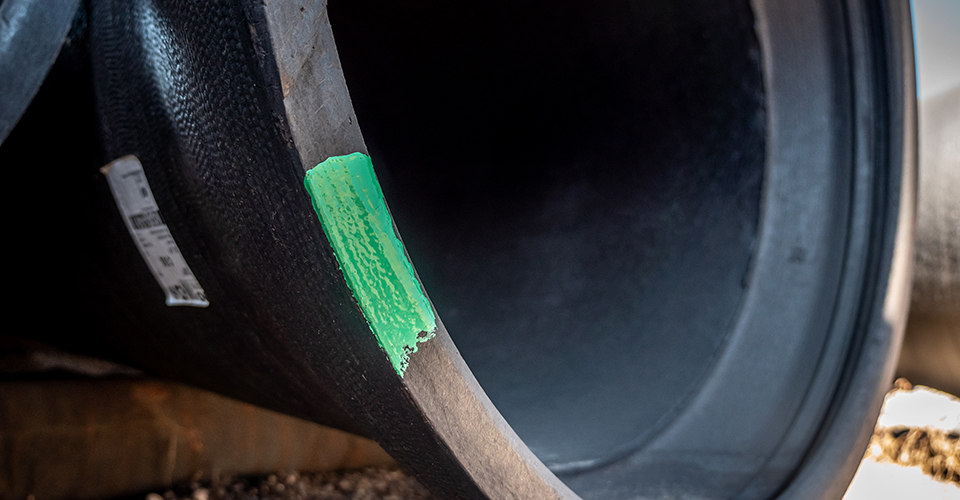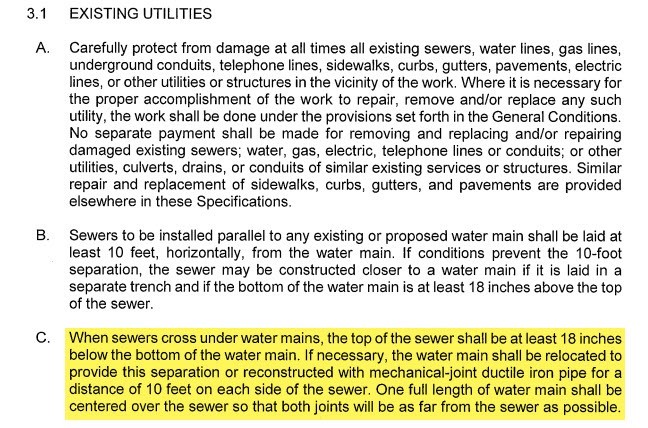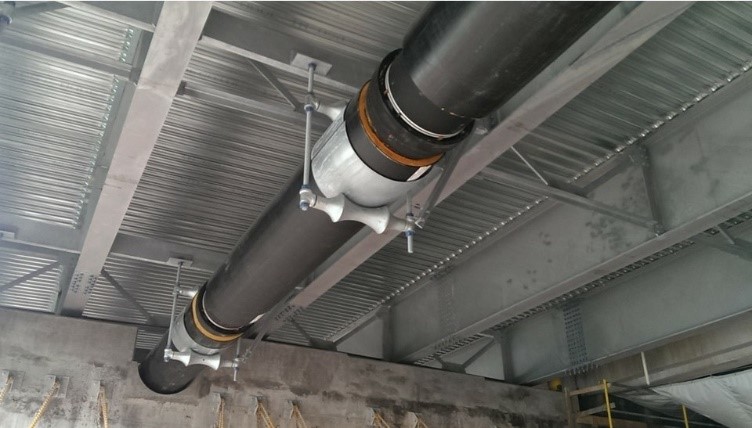One of the more frequent questions we receive in the field is, “What is the size of a piece of Ductile iron pipe?” But that question may apply to the Outside Diameter (OD) or Inside Diameter (ID) of a piece of pipe. For this Iron Strong Blog, we are going to look at a particular size of pipe to help us understand why the OD and ID’s are important to you. We will be using 24 inches as our example pipe size.
What is Outside Diameter?
The Outside Diameter (OD) of a circular object, such as a pipe, is the measurement of the distance of a straight line from one point on the outer wall of the pipe, let’s say the 12 o’clock position, through the pipe’s center to an opposite point on the outside; in this case, the 6 o’clock position.
24-inch Ductile iron pipe (DI pipe) has a nominal OD of 25.80 inches but has a minimum casting tolerance of 0.08 inches and a maximum casting tolerance of 0.05 inches. So your OD could range from 25.72 – 25.85 inches.
Use McWane's Pocket Engineer to determine your pipe’s OD by selecting the OD/ID calculator.
Why Is It So Important to Know the Outside Diameter?
There are several reasons why you may need to know the actual OD of a piece of pipe in the field, so let us look at some of those reasons:
When Cutting Pipe
Let’s say you are in the field and you need to cut a piece of pipe, the OD is going to be very important to you. First, when cutting large diameter pipe, which is pipe larger than 12 inches, you should be looking for Gauged Full Length (GFL) pipe, which will have a green "tick" mark painted on the face of the bell. For a piece of pipe to be considered GFL, it must pass three tests at the plant:
- OD Taped – we measure the OD of the pipe with an OD tape starting three inches from the spigot and every four feet along the barrel.
- The pipe is marked as regular stock if the OD is not within the tolerance range after measuring.
- Go Gauge – which measures the maximum axis of the pipe in the same locations that the pipe was taped. No-Go Gauge – which measures the minimum axis of the pipe and should not fit on the pipe.
Taped Full Length (TFL) is another designation we put on pipe that you may see in the field. You should feel comfortable cutting the pipe if you OD tape the pipe first. TFL pipe is where the pipe passed the OD Taped test at the plant but did not pass the Go Gauge or No-Go Gauge test, which caused it not to be marked as GFL. This marking is only applied to pipe diameters of 24” and larger.
However, this pipe can still be cut, but you will want to measure the OD first. I would strongly encourage that practice before you cut any piece of pipe, even if it is marked GFL. Check out another Iron Strong Blog where we discuss Ductile iron pipe lengths and why they vary, by my colleague, Jeremy Gwin, McWane Ductile Senior Sales Rep.
When Support Sizing is Needed
Some DI pipe installations require support. Therefore, you will need to know the OD of the pipe if you are installing on piers, hanging it from a bridge, or using cutouts in walls or bridge abutments.
When Joining/Tapping Materials
Sometimes, you may need to transition from an alternate pipe material, and you require a special coupling, or you are going to tap a DI pipeline. You need to know what size tapping sleeve is required, so you will need to check the OD of the pipe.
When Using Insulation
if you need to wrap DI pipe with insulation, or any other protective jacketing, then you will need to know the OD of the pipe.
When Applying Exterior Paint or Coatings
You could require special paint or epoxy on the exterior of the pipe, and in that case, you would need to know the maximum OD to configure how much paint or epoxy is needed to do the job.
Using the max OD is very important when you are trying to determine the correct amount of paint that would be needed. The formula to determine the square footage of paint needed is OD area = 3.14 x L x D. For an 18-ft piece of 24” Ductile Iron pipe with an overall length of 18.5 ft, mistakenly using 24 as the OD gets you 116.2 square feet of paint per pipe. Using the appropriate 25.85 max OD measurement, you need 125.1 square feet per pipe. If you are coating 1,000 feet of 24” pipe, this small difference adds up to nearly 500 square feet of area missing paint coverage!
When Sizing Casing Pipe and for Horizontal Directional Drilling (HDD)
These are the reasons you may need to know what size the pipe is you are working with. However, when it comes to determining what size casing pipe you need, or what size hole you need when using Ductile iron for directional drilling, the Bell OD is the dimension that you will need to know. When using Bell OD's, it is vital to know that the various joint types all have different Bell OD's. See another helpful blog on Horizontal Directional Drilling by John Simpson, McWane Ductile Regional Engineer,
- 24” Tyton® Bell OD 28.43
- 24” TR Flex® Bell OD 30.25
- 24” MJ OD 31.50
What is Inside Diameter?
The Inside Diameter (ID) can also be a very critical piece of information you may need in the field or designing a project. When determining the ID of your pipe, there are several critical factors you will need to consider:
- What is the pipe class to determine the wall thickness?
- Is the pipe bare?
- Is the pipe standard cement-lined?
- Is the pipe double cement-lined?
The first essential item you need to know when determining your pipe's ID is the class of pipe, so that you can determine the correct wall thickness of that pipe. For Instance, a 24-inch CL350 DI pipe will have a wall thickness of .43 inches. Whereas a 24-inch CL52 DI pipe, will have a wall thickness of .47 inches, so we must know the actual class of pipe when we are determining the correct ID.
The next thing we will need to know to help us calculate the proper ID, is whether the pipe is Standard Cement Lined (SCL) or Double Cement Lined (DCL). Each has a minimum thickness required attached below.
You may also be asking yourself if you have a seal coat on the inside of the pipe if that matters in determining your pipe’s ID, but the seal coat is applied at a 1-2 mills thickness, which is so thin it wouldn’t matter in determining your pipe’s ID.
An easy way to determine your pipe’s ID can be found using the McWane Pocket Engineer and selecting the OD/ID calculator.
Pipe Size | SCL | DCL |
3"-12" | 1/16" | 1/8" |
14"-24" | 3/32" | 3/16" |
30"-36" | 1/8" | 1/4" |
Why Is It So Important to Know the Inside Diameter?
Now that we have reviewed how to determine our pipe’s ID correctly, let us look at some of the reasons why the ID may be relevant to you:
When Determining Pipeline Volume
Computing the volume of water that will fill a pipeline, for things such as hydrostatic testing, you will need the ID to get this information. For example, a 1,000 feet of 24-inch CL52 DIP pipeline will hold almost 25,000 gallons of water. That is more than three 8,000-gallon tanker trucks needed to fill it.
When Calculating Flow and Energy Savings
The ID is critical in proper flow and energy needs or savings calculations. In the universal equation of Q=AV, the A is computed as A=3.14(r²), where r = ID/2. Or you could visit the McWane Pocket Engineer and its energy savings calculator.
When Mandrel Testing Or Pigging
Many utilities still require mandrel testing after installation, especially on deep sewer lines, which involves pulling a circular or spherical plate or ball through the line to confirm nothing is amiss by the backfill or other reasons. For this, you would certainly need to know what the smallest ID could be of a given diameter. Also, pipeline pigging, or a cleaning sponge, is still required in some instances: if that is the case, you would need the ID to help you determine the correct size pig.
When Applying Interior Coatings/Epoxy Liners
Just like with OD, the ID of a pipe is vital in determining the amount of paint or epoxy that would be needed to line a piece of pipe. Here, it would be important to use the largest available ID for a chosen nominal diameter.
When Using Casing Pipe and Spacers
DI pipe can often be used as a casing/carrier pipe for weaker pipes, and in some instances, you may have older abandoned Cast Iron lines that are being utilized as casing/carrier pipes. In these instances, knowing these pipe ID’s would be critical.
We have discussed how you can calculate and where to find your DI pipe’s ID, but with older Cast Iron lines, that is not as easy. So, an “old-school” pipe OD chart may be helpful for you. Also, if you are going to be using Ductile iron as a casing/carrier pipe, the ID will be valuable in selecting the proper size of casing spacers (with or without nylon skid feet). Remember not to forget to include your SCL or DCL thickness here when you are calculating the correct size of your casing spacers.
We Are Here to Assist
At times, this can seem confusing. If you have any questions or need assistance in determining your pipe’s outside or inside diameter, please contact your local McWane Ductile sales representative.
We have team members who’ve managed small and large water utility systems, served in engineering consulting firms, and bring decades of experience in solving field issues involving pipeline construction and operation. From design to installation, we strive to provide insightful education and assistance to water professionals throughout the water and wastewater industry.
Check out all our digital offerings










